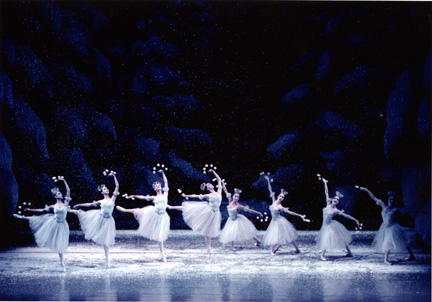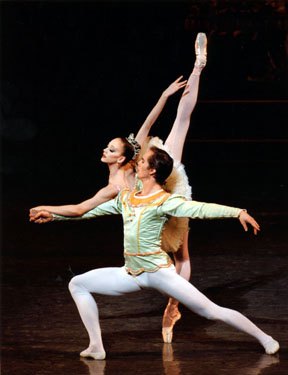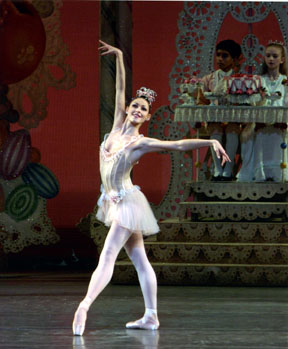Business As Usual
"The
Nutcracker"
New York City Ballet
New York State Theater
New York, NY
November 26, 2004
by Leigh Witchel
copyright
© 2004 by Leigh Witchel
 Thanksgiving
is over; the turkey has been eaten and re-eaten. For ballet lovers, “The
Nutcracker” is as much a marker of the onset of the holiday season
as the after-Thanksgiving Day sales, and New York City Ballet opened its
50th anniversary season of the production on Friday.
Thanksgiving
is over; the turkey has been eaten and re-eaten. For ballet lovers, “The
Nutcracker” is as much a marker of the onset of the holiday season
as the after-Thanksgiving Day sales, and New York City Ballet opened its
50th anniversary season of the production on Friday.
For such a momentous occasion the production had a workaday feel. The company didn’t muster its senior dancers into the principal roles, or rising stars in debuts for the cognoscenti to chatter over. It was business as usual at NYCB. Or maybe a bit brisker than usual; Andrea Quinn was conducting at a breakneck pace. I know that Balanchine preferred fast tempos, but there’s energetic dancing and then there’s having to throw oneself around just to keep up.
Act I usually has a sweet nostalgia, a Christmas card from an idealized past. It was a bit more “Married with Children” at this performance. Fritz (Nicholas Smith) was, as usual, a holy terror, but this time Marie (Angelica Fellini) was no shrinking violet either. She seemed to need little protection from him, as if she would have been quite willing to give as good as she got. The girls were in their best party dresses, but seemed as rambunctious as the boys and the parents were hard pressed to contain them. Perhaps they hadn’t yet shrugged off their modern manners to enter into the world onstage; it made the world of the mice seem somehow closer to the living room. There were interesting points to it; these are children that the children in the audience will recognize. Mr. & Mrs. Stahlbaum (Jason Fowler and Dena Abergel) may not have been idealized parents—how could one be with Fritz as your son?— but Ms. Abergel especially was warm and loving. She acts like a real mom to real children. Since last Nutcracker season, I’ve heard the entr’acte Balanchine lifted from “The Sleeping Beauty” several times in choreography by Ashton for his Awakening pas de deux. It wasn’t meant to be danced and it isn’t an egregious borrowing, but the more one hears it in other places, the more noticeable the seams are here.
 Excepting
the opening night gala, “The Nutcracker” is also our chance
to reacquaint ourselves with the company after five long months away from
home. When the battle was over and the scene changed to the journey through
the snow; I looked for familiar faces in the corps to greet me. They weren’t
there. The snowflakes were almost entirely the newest members of the company
and the apprentices; there was barely a recognizable face amidst the blizzard.
The snow scene was decently danced, though at the tempos taken it’s
a wonder the snowflakes didn’t all melt.
Excepting
the opening night gala, “The Nutcracker” is also our chance
to reacquaint ourselves with the company after five long months away from
home. When the battle was over and the scene changed to the journey through
the snow; I looked for familiar faces in the corps to greet me. They weren’t
there. The snowflakes were almost entirely the newest members of the company
and the apprentices; there was barely a recognizable face amidst the blizzard.
The snow scene was decently danced, though at the tempos taken it’s
a wonder the snowflakes didn’t all melt.
Act II was also mostly business as usual, with some brighter spots. The Ivanov mime for the Little Prince (Jerimy Rivera) is a moment in amber, like the mime Karsavina taught Ashton that he inserted into “La Fille Mal Gardée”. Neither looks like the rest of the ballet at all—the style both men worked in doesn’t transition smoothly to straight mime—but I’m still glad it’s there. Mr. Rivera, one of the few little boys who looked from a more mannerly time, performed his mime quite well.
Maria Kowroski was the Sugar Plum Fairy. It’s one of those roles that seem to box her in rather than open her up. She danced the role well but loosely, with that unfocused look and bobbing head she can get when she has to play Prima Ballerina. The tempos didn’t allow for a finished look, but there’s only so much one can blame on the conductor. Ms. Kowroski has incredible facility and a comic gift that gets buried in classical roles. She has the sort of body that matures late and we’ve been waiting for her to come into focus as a classical dancer since she entered the company. She doesn’t fit any of the archetypes; what do you do with a funny ballerina? Our best hope for her seems to be new repertory rather than what’s already been made. Charles Askegard partnered her gallantly in the truncated Cavalier role.
 Sofiane
Sylve has technique to burn; it’s as if she has suction cups on
her toes. Dancing Dewdrop she tossed off one gyroscopic turn after another,
and sailed through the air. But the greater the ability, the greater the
burden and the higher the bar to clear. Risky maneuvers have little risk
when she dances, so she must find other ways to give her dancing texture.
Teresa Reichlen is another jumper and it’s all the more striking
from her long, thin physique. Still, who would have ever thought Ms. Reichlen
could turn Coffee into a jumping part? Tea is a jumping part,
and Daniel Ulbricht is certainly an amazing jumper. His tea is certainly
not a subtly perfumed green tea, but neither is Tchaikovsky’s. Ulbricht
serves us tea with three scoops of sugar and an extra kick of caffeine
in it.
Sofiane
Sylve has technique to burn; it’s as if she has suction cups on
her toes. Dancing Dewdrop she tossed off one gyroscopic turn after another,
and sailed through the air. But the greater the ability, the greater the
burden and the higher the bar to clear. Risky maneuvers have little risk
when she dances, so she must find other ways to give her dancing texture.
Teresa Reichlen is another jumper and it’s all the more striking
from her long, thin physique. Still, who would have ever thought Ms. Reichlen
could turn Coffee into a jumping part? Tea is a jumping part,
and Daniel Ulbricht is certainly an amazing jumper. His tea is certainly
not a subtly perfumed green tea, but neither is Tchaikovsky’s. Ulbricht
serves us tea with three scoops of sugar and an extra kick of caffeine
in it.
In the business as usual world, it was hard to find the magic or poetry in the performance. But perhaps only for adult eyes. The ballet is meant for eyes we have left behind, and those eyes see magic in places other than the plot or dancing. It wasn’t the growing Christmas trees that got the most applause. It was when the curtain rose on Act II and the children in the audience saw a lacy and brilliant world concocted entirely of sweets.
Photos (all by Paul
Kolnik):
First, the company in the Snow Scene.
Second, Maria Kowroski and Charles Askegard as Sugar Plum and her Cavalier.
Third, Sofiane Sylve as Dewdrop.
Volume
2, No. 45
November 29, 2004
www.danceviewtimes.com
Copyright
©2004 by Leigh Witchel
|
|
|